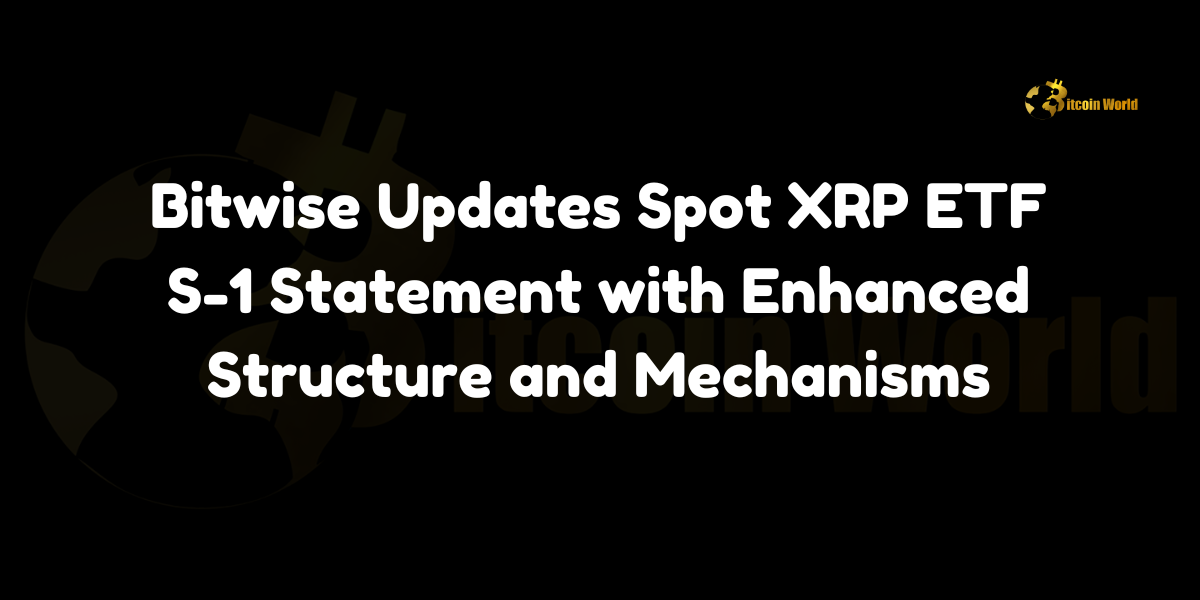[ad_1]
Cryptocurrency asset management company Bitwise has taken a significant step forward in its pursuit of launching a Spot XRP Exchange-Traded Fund (ETF) by submitting an updated S-1 registration statement to the U.S. Securities and Exchange Commission (SEC) on October 16, 2024. This update, as reported by Crypto Briefing, includes more specific details regarding the ETF’s structure, custody agreement, and redemption mechanism, building upon the initial S-1 filing submitted on October 2. This development marks a critical milestone in the ongoing efforts to provide regulated investment vehicles for XRP, one of the most prominent cryptocurrencies in the market.
Understanding the Spot XRP ETF
A Spot XRP ETF is a financial product designed to track the real-time price movements of XRP, offering investors a way to gain exposure to the cryptocurrency without directly purchasing or holding it. Unlike futures-based ETFs, which derive their value from XRP futures contracts, a spot ETF is directly backed by the underlying asset, in this case, XRP. This direct linkage aims to provide more accurate price tracking and eliminate the complexities associated with futures contracts, such as contango and backwardation.
Importance of XRP in the Crypto Market
XRP, developed by Ripple Labs, is a digital asset designed to facilitate fast and cost-effective cross-border payments. It has gained substantial traction among financial institutions and payment providers, positioning itself as a viable alternative to traditional banking systems for international money transfers. The establishment of a Spot XRP ETF would further legitimize XRP as a mainstream investment asset, potentially attracting a broader range of institutional and retail investors.
Detailed Enhancements in the Updated S-1 Statement
The updated S-1 filing by Bitwise introduces several critical enhancements aimed at addressing regulatory concerns and providing greater transparency to potential investors. These enhancements are pivotal in aligning the ETF’s operations with SEC requirements and ensuring the protection of investor interests.
1. ETF Structure
Bitwise has provided a more comprehensive outline of the ETF’s structure, detailing how XRP will be acquired, held, and managed within the fund. This includes:
- Acquisition Strategy: The ETF will acquire XRP directly from cryptocurrency exchanges, ensuring that the holdings reflect the current market price of XRP. This direct acquisition minimizes tracking error and ensures that the ETF accurately mirrors the price movements of XRP.
- Holding Mechanism: XRP will be securely stored in cold storage solutions to protect against cyber threats and theft. Bitwise has partnered with reputable custodians specializing in digital asset security to manage the custody of XRP holdings, ensuring compliance with industry best practices.
- Management Approach: The ETF will employ a passive management strategy, aiming to replicate the performance of XRP by maintaining an equivalent amount of XRP in the fund. This approach reduces operational complexities and aligns the ETF’s performance closely with the underlying asset.
2. Custody Agreement
Custody is a critical aspect of any cryptocurrency ETF, given the unique challenges associated with securely storing digital assets. Bitwise has elaborated on its custody agreements to provide greater assurance of security and regulatory compliance:
- Cold Storage Solutions: XRP holdings will be kept in offline cold storage environments, significantly reducing the risk of hacking and unauthorized access. This method ensures that the digital assets are insulated from online threats.
- Insurance Coverage: To further safeguard investor assets, Bitwise has secured comprehensive insurance policies covering potential losses due to theft, hacking, or other security breaches. This insurance coverage provides an additional layer of protection, enhancing investor confidence.
- Regulatory Compliance: The custody arrangements are designed to comply with SEC regulations and industry standards, ensuring that the ETF adheres to all legal and security requirements. Regular audits and assessments will be conducted to maintain compliance and security integrity.
3. Redemption Mechanism
The redemption mechanism is another crucial component addressed in the updated S-1 filing, outlining how investors can redeem their shares in the ETF:
- In-Kind Redemption: The ETF will utilize an in-kind redemption process, allowing authorized participants to exchange ETF shares for XRP holdings directly. This method minimizes the need for selling XRP in the open market, reducing potential price impact and maintaining market stability.
- Liquidity Management: Bitwise has implemented robust liquidity management strategies to ensure that the ETF can meet redemption requests efficiently without disrupting the XRP market. This includes maintaining a sufficient buffer of XRP holdings to handle large-scale redemptions.
- Transparent Reporting: The ETF will provide transparent and timely reporting on redemption activities, ensuring that investors are well-informed about the ETF’s operations and the status of their investments.
Regulatory Landscape and SEC Approval
Launching a Spot XRP ETF involves navigating a complex regulatory landscape, with the SEC playing a pivotal role in determining the viability and compliance of the fund. Bitwise’s updated S-1 filing aims to address the SEC’s concerns regarding market manipulation, custody, liquidity, and investor protection.
Addressing Market Manipulation Concerns
One of the primary concerns of the SEC has been the potential for market manipulation within the cryptocurrency markets. Bitwise has implemented several measures to mitigate these risks:
- Robust Surveillance Systems: The ETF will employ advanced surveillance systems to monitor trading activities and detect any signs of manipulation or fraudulent behavior. This proactive approach helps in maintaining market integrity.
- Exchange Partnerships: By partnering with reputable cryptocurrency exchanges, Bitwise ensures that XRP acquisitions are conducted through transparent and regulated platforms, reducing the likelihood of manipulation.
- Regular Audits: Independent audits will be conducted regularly to assess the ETF’s operations and compliance with anti-manipulation regulations. These audits provide an additional layer of oversight and accountability.
Ensuring Liquidity and Price Stability
The SEC requires that ETFs maintain sufficient liquidity to handle investor transactions without causing significant price disruptions. Bitwise has outlined comprehensive liquidity management strategies to meet these requirements:
- Sufficient Reserves: The ETF will maintain a substantial reserve of XRP to accommodate large-scale buy and sell orders, ensuring that investor transactions can be executed smoothly.
- Dynamic Rebalancing: The fund will employ dynamic rebalancing techniques to adjust XRP holdings in response to market conditions, maintaining an optimal balance between liquidity and investment objectives.
- Transparent Pricing: Bitwise will ensure that the ETF’s pricing accurately reflects the current market value of XRP, providing investors with fair and transparent valuation of their holdings.
Investor Protection and Transparency
Investor protection is a cornerstone of SEC regulations. Bitwise has incorporated several features to enhance transparency and safeguard investor interests:
- Detailed Disclosures: The S-1 filing includes comprehensive disclosures about the ETF’s structure, investment strategies, risks, and operational procedures, ensuring that investors are fully informed.
- Regular Reporting: The ETF will provide regular reports on its holdings, performance, and operational activities, promoting transparency and accountability.
- Risk Management Framework: A robust risk management framework will be in place to identify, assess, and mitigate potential risks associated with the ETF’s operations and the underlying XRP asset.
Market Implications and Investor Interest
The submission of an updated Spot XRP ETF S-1 statement by Bitwise is likely to generate significant interest among investors and market participants. The approval of such an ETF could have several implications for the cryptocurrency and financial markets:
Increased Institutional Adoption
A regulated Spot XRP ETF would provide institutional investors with a compliant and secure avenue to gain exposure to XRP, potentially leading to increased institutional participation in the cryptocurrency market. This could drive higher liquidity and stability for XRP, enhancing its market position.
Enhanced Accessibility for Retail Investors
Retail investors seeking to invest in XRP without navigating the complexities of cryptocurrency exchanges and wallets would benefit from the ETF structure. This accessibility can broaden the investor base, contributing to greater demand and price appreciation for XRP.
Legitimization of XRP as a Financial Asset
The approval of a Spot XRP ETF by the SEC would serve as a significant endorsement of XRP’s legitimacy as a financial asset. This recognition could bolster XRP’s reputation, encouraging further adoption and integration within traditional financial systems.
Market Liquidity and Price Stability
The introduction of a Spot XRP ETF could enhance market liquidity by providing a steady stream of investments and redemptions. This increased liquidity can contribute to more stable price movements, reducing volatility and making XRP a more attractive investment option.
Impact on Competing Cryptocurrencies
The approval and success of a Spot XRP ETF could influence the landscape for other cryptocurrencies seeking similar regulatory approval. It could set a precedent for the approval process, providing a blueprint for other digital assets aiming to launch regulated ETFs.
Challenges and Potential Roadblocks
Despite the promising developments, Bitwise faces several challenges and potential roadblocks in obtaining SEC approval for the Spot XRP ETF:
Regulatory Scrutiny
The SEC has been cautious in approving cryptocurrency ETFs, citing concerns over market manipulation, liquidity, and investor protection. Bitwise must convincingly demonstrate that it has robust measures in place to address these concerns and comply with all regulatory requirements.
Market Manipulation Risks
The cryptocurrency market is still relatively nascent and susceptible to manipulation. Bitwise must ensure that its surveillance and compliance mechanisms are advanced enough to detect and prevent any manipulative activities, thereby satisfying the SEC’s stringent standards.
Technical and Operational Challenges
Integrating a Spot XRP ETF involves complex technical and operational considerations, including secure custody solutions, efficient redemption processes, and accurate pricing mechanisms. Bitwise must navigate these challenges effectively to ensure the seamless operation of the ETF.
Competition from Other ETF Filings
Bitwise is not alone in seeking SEC approval for a cryptocurrency ETF. Competing filings from other asset managers could result in a crowded approval process, increasing the competition for SEC attention and resources.
Market Volatility
The inherent volatility of XRP and the broader cryptocurrency market poses a challenge in maintaining price stability and meeting SEC requirements for liquidity and investor protection. Bitwise must implement effective risk management strategies to mitigate the impact of price fluctuations.
Future Prospects and Strategic Plans
Looking ahead, Bitwise has outlined several strategic plans to enhance its position in the cryptocurrency ETF market and address potential challenges:
Continuous Engagement with Regulators
Bitwise plans to maintain open and transparent communication with the SEC throughout the approval process. By proactively addressing regulatory concerns and providing comprehensive documentation, Bitwise aims to build a strong case for its Spot XRP ETF.
Enhancing Technological Infrastructure
To ensure the secure and efficient operation of the ETF, Bitwise is investing in advanced technological infrastructure. This includes robust custody solutions, real-time price tracking systems, and automated compliance tools to streamline operations and enhance security.
Expanding Custody Partnerships
Bitwise is exploring partnerships with leading custodians specializing in digital asset security. These partnerships will bolster the ETF’s custody arrangements, ensuring that XRP holdings are protected against cyber threats and theft.
Investor Education and Outreach
Bitwise recognizes the importance of educating investors about the benefits and risks associated with investing in a Spot XRP ETF. The company plans to conduct outreach initiatives, webinars, and informational campaigns to inform potential investors and address their queries.
Diversification of ETF Offerings
In addition to the Spot XRP ETF, Bitwise is considering the development of other cryptocurrency-based ETFs, aiming to provide a diverse range of investment options for both institutional and retail investors. This diversification strategy can help mitigate risks and cater to varying investment preferences.
Leveraging Data Analytics and AI
Bitwise intends to leverage data analytics and artificial intelligence (AI) to enhance its market surveillance and compliance capabilities. Advanced analytics can help in detecting anomalous trading patterns and potential manipulation, ensuring the integrity of the ETF’s operations.
Comparative Analysis: Spot XRP ETF vs. Futures-Based ETFs
Understanding the differences between Spot XRP ETFs and futures-based ETFs is essential for investors to make informed decisions.
Spot XRP ETF
- Underlying Asset: Directly backed by XRP held in custody.
- Price Tracking: Mirrors the real-time price of XRP, ensuring accurate performance.
- Volatility: Potentially less susceptible to contango and backwardation issues.
- Regulatory Compliance: Must adhere to SEC requirements for custody, liquidity, and investor protection.
- Investor Appeal: Attracts investors seeking direct exposure to XRP without the complexities of futures contracts.
Futures-Based ETFs
- Underlying Asset: Based on XRP futures contracts rather than the spot price.
- Price Tracking: May not perfectly align with the spot price due to the complexities of futures markets.
- Volatility: Subject to contango and backwardation, which can impact performance.
- Regulatory Compliance: Faces different regulatory challenges related to futures trading.
- Investor Appeal: Appeals to investors interested in speculative trading and leveraged exposure to XRP.
Advantages of Spot XRP ETF
- Accuracy in Price Tracking: Directly linked to XRP’s spot price ensures that the ETF’s performance accurately reflects the underlying asset.
- Simplicity: Easier for investors to understand without the complexities associated with futures contracts.
- Lower Operational Risks: Reduced risks related to futures trading mechanisms like contango and backwardation.
Disadvantages of Spot XRP ETF
- Higher Custody Requirements: Requires robust custody solutions to securely hold XRP.
- Regulatory Hurdles: Must meet stringent SEC requirements for spot asset-backed ETFs.
- Market Manipulation Risks: Must implement advanced surveillance systems to prevent manipulation.
Investor Considerations: Evaluating the Spot XRP ETF
Investors contemplating the Spot XRP ETF should consider several factors to assess its suitability for their investment portfolios.
Investment Goals and Risk Tolerance
Understanding one’s investment goals and risk tolerance is crucial. While the Spot XRP ETF offers direct exposure to XRP, it is still subject to the volatility inherent in cryptocurrency markets. Investors should evaluate whether the potential rewards align with their risk appetite.
Regulatory Confidence
The approval and regulation of the Spot XRP ETF by the SEC provide a level of confidence regarding the fund’s compliance and operational integrity. Investors should consider the regulatory framework and Bitwise’s adherence to it as indicators of the ETF’s reliability.
Custody and Security Measures
The ETF’s custody arrangements play a vital role in safeguarding XRP holdings. Investors should assess the security measures in place, including the use of cold storage, insurance coverage, and partnerships with reputable custodians.
Liquidity and Redemption Mechanism
The liquidity of the ETF and the efficiency of its redemption mechanism are important factors for investors. A well-structured redemption process ensures that investors can easily buy and sell ETF shares without significant price impacts.
Fee Structure
Understanding the ETF’s fee structure, including management fees and custody costs, is essential for evaluating its cost-effectiveness. Lower fees can enhance net returns, making the ETF a more attractive investment option.
Market Sentiment and Performance
Monitoring market sentiment and the ETF’s performance relative to XRP’s price movements can provide insights into its effectiveness in tracking the underlying asset. Investors should regularly review performance reports and market analyses to stay informed.
Potential Market Impact of the Spot XRP ETF
The introduction of a Spot XRP ETF by Bitwise could have several ripple effects across the cryptocurrency and financial markets:
Enhanced XRP Liquidity
A regulated ETF can significantly increase XRP’s liquidity by attracting new investment flows from institutional and retail investors. Higher liquidity can lead to more stable price movements and reduced volatility, benefiting all market participants.
Increased Market Credibility
The approval of a Spot XRP ETF by the SEC would enhance XRP’s credibility as a legitimate financial asset. This recognition can attract more investors, fostering broader adoption and integration within traditional financial systems.
Influence on Cryptocurrency Regulations
The successful launch and operation of a Spot XRP ETF could influence future regulatory decisions regarding other cryptocurrency-based ETFs. It may set a precedent for the approval process and establish best practices for cryptocurrency fund management.
Competitive Dynamics in the ETF Market
Bitwise’s move to launch a Spot XRP ETF could spur other asset managers to develop similar products for different cryptocurrencies. This competition can lead to a more diverse and robust ETF market, offering investors a wider range of investment options.
Impact on XRP’s Market Price
The increased demand from ETF investments can drive XRP’s market price higher, benefiting existing holders and attracting new investors. Conversely, the potential for large-scale redemptions could also impact price dynamics, necessitating effective liquidity management strategies.
Case Studies: Successful Cryptocurrency ETFs
Examining successful cryptocurrency ETFs provides valuable insights into the potential trajectory of the Spot XRP ETF.
ProShares Bitcoin Strategy ETF (BITO)
Launched in October 2021, ProShares Bitcoin Strategy ETF (BITO) was the first Bitcoin futures-based ETF approved by the SEC. It quickly gained significant investor interest, demonstrating the demand for regulated cryptocurrency investment products. BITO’s success highlighted the potential for futures-based ETFs, setting the stage for future cryptocurrency ETF approvals.
Grayscale Bitcoin Trust (GBTC)
While not an ETF, Grayscale Bitcoin Trust (GBTC) serves as a notable example of a Bitcoin investment vehicle. GBTC allows investors to gain exposure to Bitcoin without directly holding the cryptocurrency, similar to how a Spot XRP ETF would function. The trust’s performance and investor interest provide a benchmark for evaluating the potential success of cryptocurrency ETFs.
Purpose Bitcoin ETF (BTCC)
Launched in Canada, Purpose Bitcoin ETF (BTCC) was the first Bitcoin spot ETF to gain approval. Its success in the Canadian market demonstrated the viability and investor demand for spot-based cryptocurrency ETFs. BTCC’s operations offer valuable lessons for Bitwise as it seeks SEC approval for its Spot XRP ETF.
Ethereum ETFs
Several Ethereum-based ETFs are in various stages of development and approval. These ETFs aim to provide exposure to Ethereum’s price movements, similar to the proposed Spot XRP ETF. The progress and outcomes of these Ethereum ETFs can influence Bitwise’s strategy and expectations for its XRP offering.
Strategic Responses and Future Developments
As Bitwise progresses with its Spot XRP ETF, strategic responses and future developments will shape its trajectory and market reception.
Continuous Engagement with the SEC
Maintaining open lines of communication with the SEC is essential for addressing any regulatory concerns and facilitating the approval process. Bitwise plans to engage in ongoing discussions with regulators to ensure compliance and transparency.
Enhancing Technological Infrastructure
To support the ETF’s operations, Bitwise is investing in advanced technological infrastructure, including secure custody solutions, real-time price tracking systems, and automated compliance tools. These investments aim to enhance the ETF’s efficiency, security, and reliability.
Expanding Partnerships and Collaborations
Bitwise is exploring partnerships with leading cryptocurrency exchanges, custodians, and financial institutions to strengthen the ETF’s operational framework. Collaborations with reputable partners can enhance the ETF’s credibility and market reach.
Investor Education and Transparency Initiatives
Bitwise recognizes the importance of educating investors about the Spot XRP ETF’s benefits and risks. The company plans to launch educational campaigns, webinars, and informational resources to inform potential investors and foster informed decision-making.
Exploring Additional Cryptocurrency ETFs
Building on the success of the Spot XRP ETF, Bitwise is considering the launch of additional cryptocurrency-based ETFs. These offerings aim to provide investors with diverse exposure to different digital assets, catering to varying investment preferences and strategies.
Conclusion
Bitwise’s submission of an updated Spot XRP ETF S-1 registration statement to the SEC marks a pivotal advancement in the quest to provide regulated investment vehicles for XRP. By enhancing the ETF’s structure, custody arrangements, and redemption mechanisms, Bitwise addresses critical regulatory concerns and sets a strong foundation for potential SEC approval. The successful launch of a Spot XRP ETF could significantly impact the cryptocurrency and financial markets by increasing institutional and retail investment in XRP, enhancing liquidity, and legitimizing XRP as a mainstream financial asset.
However, Bitwise must navigate the complex regulatory landscape and address potential challenges related to market manipulation, volatility, and operational integration to achieve its objectives. The outcome of this endeavor will not only influence Bitwise’s standing in the market but also set important precedents for the broader cryptocurrency ETF landscape.
As the financial industry continues to embrace digital assets, the development and approval of Spot XRP ETFs represent a critical step towards the mainstream integration of cryptocurrencies into traditional investment portfolios. Investors and market participants will closely monitor Bitwise’s progress, anticipating the potential benefits and implications of this innovative financial product.
To learn more about the innovative startups shaping the future of the crypto industry, explore our latest news article, where we delve into the most promising ventures and their potential to disrupt traditional industries.
Disclaimer: The information provided is not trading advice, Bitcoinworld.co.in holds no liability for any investments made based on the information provided on this page. We strongly recommend independent research and/or consultation with a qualified professional before making any investment decisions.
[ad_2]
Source link





